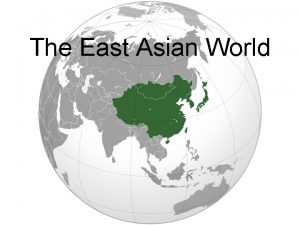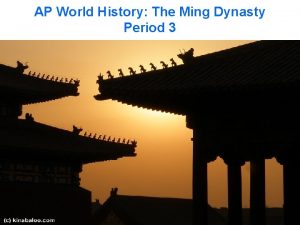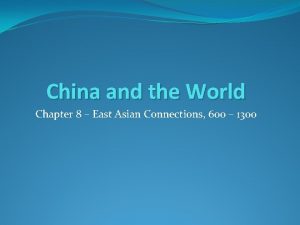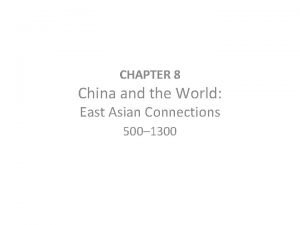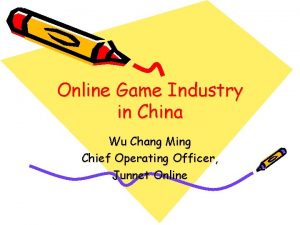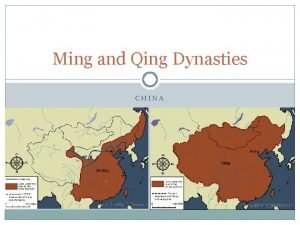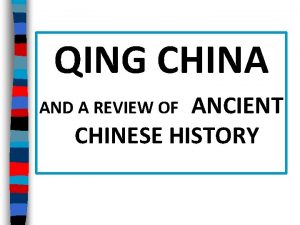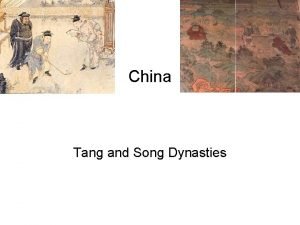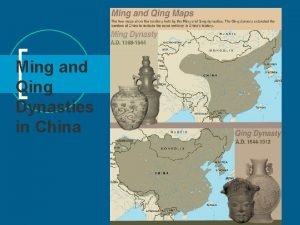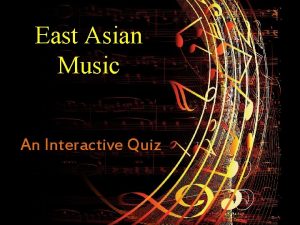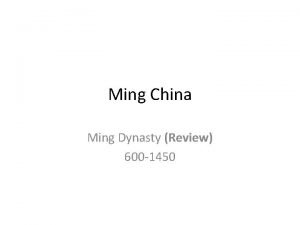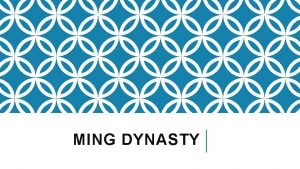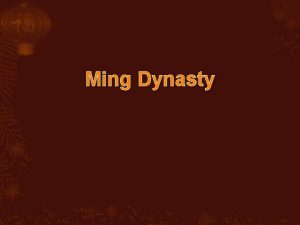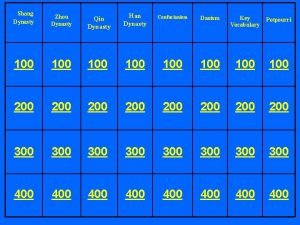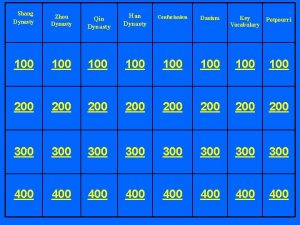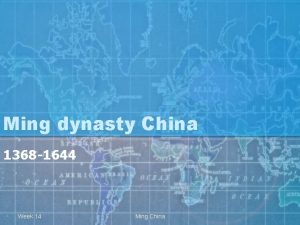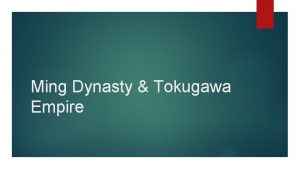The East Asian World Rise of Ming Dynasty














- Slides: 14

The East Asian World

• Rise of Ming Dynasty – – Outline Zheng He Contact with Europeans Culture/Society Decline of Ming • Rise of Qing Dynasty – Kangxi – European influence – Culture/Society • Tokugawa Japan – European influence – Economy and society • Korea

• 1368 -1644 • Ruler was Ming Hong Wu, or “Ming Martial Emperor” • China grew to include parts of Mongolia, Central Asia, and Vietnam • Ming improvements Rise of the Ming Dynasty – – Centralized government School systems Factories for producing goods Public works projects like canals for shipping – Introduction of new, easier to produce, crops

• Voyages of Zheng He – Yong Le, son of Ming Hong Wu, begins voyages into Indian Ocean – Made an enormous profit through trade…but some did not agree with trade • Confucius ideas condemned it – Voyages halted following Yong Le’s death (1424) • Contact with Europeans – Portuguese arrive in 1514, first contact since Marco Polo • Brought Christian missionaries • Exchange of ideas was biggest gain (no trade) – Chinese saw themselves as superior to European “barbarians” Exploration and Invitation

Fall of the • Problems within the Ming Dynasty empire – Weak rulers, high taxes, and poor crop production all led to a downfall – Disease epidemic also killed thousands • Li Zicheng’s peasant revolt – Sparked by epidemic – Capital city of Beijing taken in 1644 – Fighting over who would rule China ensued

• Manchu Dynasty Rise of the Qing Dynasty – Came from Manchuria, area northeast of the Great Wall • Made up 1% of Chinese population – Conquered Zicheng’s army, taking control of China • Qing adaptations – All Chinese men had to shave heads and braid their hair into a pigtail called a queue – The Manchu people were made “distinct” from all other people • Most were made nobles • Some were made banners, the chief Chinese fighting force – Chose to share power with the Chinese • 80% of government jobs owned by Chinese

• Qing economy – Popularity of artwork like blue and white porcelain grows – Growth in business and jobs • Higher population and food production – Did not see commercial capitalism, or private business based off profit, we see in Europe • Government controlled business • Agricultural jobs still the biggest employer

• Kangxi’s rule Reign of Kangxi – 1661 -1722 – Ruled for longest period in the history of China • Expansion – Stopped revolts within China – Gained territories in Taiwan, Vietnam, Russia, Mongolia, & Tibet • Religion – 1692 – Issues Edict of Toleration allowing worship of Christianity, as well as missionaries • Christians split on issue of ancestor worship – 1715 – Pope condemns ancestor worship in China • Kangxi forbides missionaries, says they cause trouble

• Qianlong – Ruled 1736 -1795 – Weak ruler, corruption grows in China White Lotus Rebellion – 1796 -1804 – Launched in response to high taxes, weak rule, corruption – Rebellion is stopped, but at great cost to Qing dynasty European interference – See moment of weakness as opportunity – Chinese allow trade, but under strict rules – British request more open trade with the Chinese • Told the Chinese do not need the British or their manufacturers Role of Europeans • •

• The Chinese family – Society revolves around the family Family Life – Individuals sacrificed their desires for benefit of family – Extended family – grandparents, children, and children’s spouses under same roof – Clan – Up to hundreds of families sharing religious and social activities • Role of women – – Inferior to men Could not be educated Could not divorce or inherit property If they did not produce a son, a second wife could be picked up

• Rise Tokugawa Japan – 250 separate territories called hans – Daimyo, or heads of noble families, ruled and controlled their own lands • Controlled by a hostage system in which their families are held under shogunate custody – Late 1500 s, 3 leaders emerged to change this • Oda Nobunga – Seized the capital, Kyoto, and began the change • Toyotomi Hideyoshi – Inherited power from Oda – Persuaded many daimyo to surrender power • Tokugawa Ieyasu – Inherited power from Toyotomi – Took complete control of Japan, creating central authority and beginning the “Great Peace”

• Portuguese arrive in 1543 European Influence – Want to capitalize on Japanese trade with China • Goods – Japanese impressed with European goods – Use guns to conquer enemies • Religion – Francis Xavier is first missionary – Thousands converted • Kicking out Europeans – Christian practice of destroying shrines upsets Japanese, Europeans booted – A small Dutch community is allowed to remain and trade

• Trade – Like Chinese, Japanese reluctant to trade (Confucius) – Tokugawa rule encourages trade Economy and Society • Class System – 4 classes • Warriors, peasants, artisans, and merchants • Below these are the eta, or Japanese outcasts – Marriage between classes is forbidden • Role of Women – Parents arranged marriages, wife moved in with husband’s family – Valued for role of child bearers and homemakers • Culture – Literature, theater, and art grew in popularity and importance

• Yi Dynasty Korea • Rulers patterned their economy and society after the Chinese • Because of isolation, Korea known as “the Hermit Kingdom” • 1630 s – After being weakened by Japanese invaders, Koreans are conquered by Chinese
 Rise of the ming dynasty
Rise of the ming dynasty Shang dynasty timeline
Shang dynasty timeline Chapter 8 china and the world east asian connections
Chapter 8 china and the world east asian connections Chapter 8 china and the world east asian connections
Chapter 8 china and the world east asian connections Chartch
Chartch Ming dynasty game online
Ming dynasty game online Rise of the qing dynasty
Rise of the qing dynasty Ming and qing dynasty
Ming and qing dynasty How did the ming dynasty restore chinese rule to china?
How did the ming dynasty restore chinese rule to china? Bureaucracy
Bureaucracy The wing dynasty
The wing dynasty Tang vs song dynasty venn diagram
Tang vs song dynasty venn diagram Qing conquest of the ming
Qing conquest of the ming Ming dynasty
Ming dynasty How is the arirang song classified?
How is the arirang song classified?
